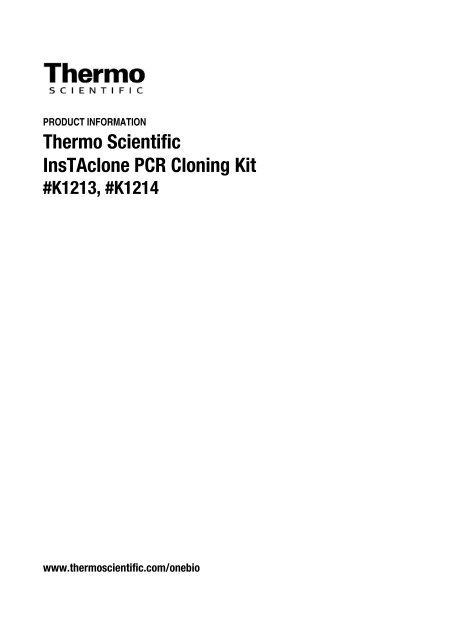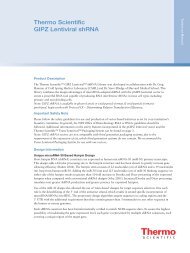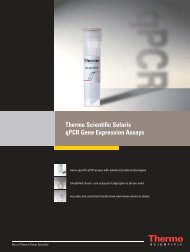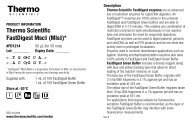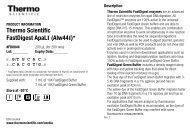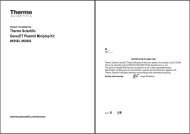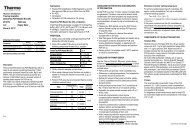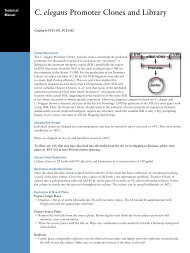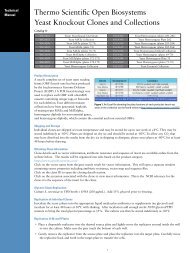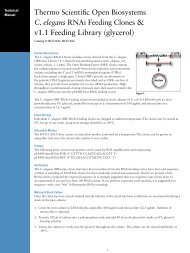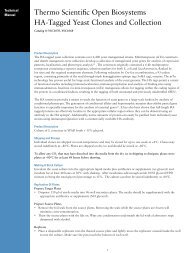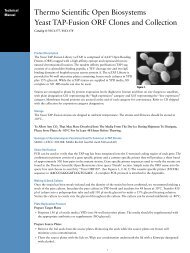InsTAclone PCR Cloning Kit - Thermo Scientific
InsTAclone PCR Cloning Kit - Thermo Scientific
InsTAclone PCR Cloning Kit - Thermo Scientific
Create successful ePaper yourself
Turn your PDF publications into a flip-book with our unique Google optimized e-Paper software.
PRODUCT INFORMATION<br />
<strong>Thermo</strong> <strong>Scientific</strong><br />
<strong>InsTAclone</strong> <strong>PCR</strong> <strong>Cloning</strong> <strong>Kit</strong><br />
#K1213, #K1214<br />
www.thermoscientific.com/onebio
#___<br />
Lot __<br />
CERTIFICATE OF ANALYSIS<br />
All components of the kit were function tested in control experiment as described in the manual.<br />
A 2.5 µl aliquot of the ligation mixture was used to transform 50 µl of chemically competent<br />
XL1-Blue cells of >10 6 cfu/µg DNA transformation efficiency.<br />
<strong>Cloning</strong> efficiency of the Control <strong>PCR</strong> Product into the pTZ57R/T was >10 5 cfu/µg DNA.<br />
>90% of the recombinant (white) colonies contained plasmids with the appropriate size insert.<br />
<strong>Thermo</strong> <strong>Scientific</strong> TransformAid Bacterial Transformation <strong>Kit</strong> (T-Solutions (A) and (B) and C-<br />
Medium) was tested for transformation efficiency of E.coli strains XL1-Blue and JM107.<br />
Competent cells prepared with this kit were transformed with supercoiled pUC19 DNA with the<br />
efficiency of >10 6 cfu/µg DNA.<br />
Quality authorized by: Jurgita Zilinskiene<br />
Rev.9. FFF
CONTENTS page<br />
COMPONENTS OF THE KIT ........................................................ 2<br />
STORAGE ..................................................................................... 2<br />
DESCRIPTION .............................................................................. 3<br />
CLONING PRINCIPLE .................................................................. 3<br />
IMPORTANT NOTES .................................................................... 4<br />
CONSIDERATIONS FOR CLONING LONG <strong>PCR</strong> PRODUCTS .... 5<br />
CLONING PROTOCOL ................................................................. 6<br />
Ligation ................................................................................. 6<br />
Transformation ..................................................................... 7<br />
ANALYSIS OF RECOMBINANT CLONES .................................... 9<br />
CONTROL EXPERIMENT ........................................................... 10<br />
MAP AND FEATURES OF pTZ57R/T CLONING VECTOR ........ 11<br />
TROUBLESHOOTING ................................................................ 13<br />
RECIPES .................................................................................... 15<br />
REFERENCES ............................................................................ 16<br />
SAFETY INFORMATION ............................................................ 16<br />
1
Component<br />
COMPONENTS OF THE KIT<br />
2<br />
#K1213<br />
10 reactions<br />
#K1214<br />
30 reactions<br />
Vector pTZ57R/T, 55 ng/µl 30 µl 90 µl<br />
5X Ligation Buffer 100 µl 300 µl<br />
T4 DNA Ligase, 5 u*/µl 15 µl 30 µl<br />
Control <strong>PCR</strong> Fragment, 42 ng/µl<br />
953 bp long<br />
Control DNA 1, 0.1 µg/µl<br />
circular supercoiled plasmid vector pTZ57R DNA<br />
without insert, 2886 bp<br />
Control DNA 2, 0.1 µg/µl<br />
circular supercoiled plasmid vector pTZ57R DNA<br />
with inserted control <strong>PCR</strong> fragment, 3839 bp<br />
8 µl 20 µl<br />
12 µl 30 µl<br />
12 µl 30 µl<br />
Water, nuclease-free 1.25 ml 1.25 ml<br />
Components of TransformAid Bacterial Transformation <strong>Kit</strong>**<br />
C-Medium 35 ml 2x35 ml<br />
T-Solution (A) 2x1.25 ml 4x1.25 ml<br />
T-Solution (B) 2x1.25 ml 4x1.25 ml<br />
* Weiss unit.<br />
** Bacterial cells are not included.<br />
STORAGE<br />
All components of the kit should be stored at -20°C. The C-Medium can be stored at 4°C for<br />
up to two months or at -20°C for longer periods.
DESCRIPTION<br />
The <strong>Thermo</strong> <strong>Scientific</strong> <strong>InsTAclone</strong> <strong>PCR</strong> <strong>Cloning</strong> <strong>Kit</strong> is a TA system for direct one-step cloning<br />
of <strong>PCR</strong> products with 3’-dA overhangs (1). The high quality TA cloning vector pTZ57R/T is<br />
ready to use for efficient ligation with <strong>PCR</strong> products providing high cloning yields and low<br />
background. To increase the speed, convenience and efficiency of cloning, the <strong>InsTAclone</strong> <br />
<strong>PCR</strong> <strong>Cloning</strong> <strong>Kit</strong> has been combined with the TransformAid Bacterial Transformation <strong>Kit</strong> – a<br />
set of solutions for preparation of chemically competent E. coli cells. According to our protocol,<br />
ligation and preparation of competent cells is performed in parallel. Therefore, it only takes<br />
approximately one hour from the completion of <strong>PCR</strong> to plating of transformed cells. Our<br />
transformation protocol is often faster than transformation of commercially available competent<br />
cells.<br />
The DNA insert can be readily excised from the versatile polylinker of pTZ57R/T, sequenced<br />
using standard M13/pUC primers or in vitro transcribed with T7 RNA polymerase.<br />
CLONING PRINCIPLE<br />
The <strong>InsTAclone</strong> <strong>PCR</strong> <strong>Cloning</strong> <strong>Kit</strong> takes advantage of the terminal transferase activity of<br />
Taq DNA polymerase and other non-proofreading thermostable DNA polymerases. Such<br />
enzymes add a single 3’-A overhang to both ends of the <strong>PCR</strong> product. The structure of these<br />
<strong>PCR</strong> products favors direct cloning into a linearized cloning vector with single 3’-ddT overhangs.<br />
Such overhangs at the vector cloning site not only facilitate cloning, but also prevent the<br />
recircularization of the vector. As a result, more than 90% of recombinant clones contain the<br />
vector with an insert. Recombinant clones are selected based on blue/white screening.<br />
Fig. 1. <strong>PCR</strong> product cloning with <strong>InsTAclone</strong> <strong>PCR</strong> <strong>Cloning</strong> <strong>Kit</strong>.<br />
3
IMPORTANT NOTES<br />
• Include final extension step in the <strong>PCR</strong> cycling protocol to ensure efficient 3’-dA tailing<br />
of the <strong>PCR</strong> product. The final extension step prolonged to 20-30 minutes generally yields<br />
3-4 fold higher numbers of recombinant clones.<br />
• Thoroughly mix every vial before use.<br />
• The <strong>InsTAclone</strong> <strong>PCR</strong> <strong>Cloning</strong> <strong>Kit</strong> is compatible with all <strong>PCR</strong> buffers supplied by <strong>Thermo</strong><br />
<strong>Scientific</strong>.<br />
• Gel-analyze the <strong>PCR</strong> product for specificity and yield before cloning.<br />
• Specific <strong>PCR</strong> products of
CONSIDERATIONS FOR CLONING LONG <strong>PCR</strong> PRODUCTS<br />
Short DNA fragments (
CLONING PROTOCOL<br />
Please read all IMPORTANT NOTES on page 4 before starting.<br />
Ligation<br />
1. Set up the ligation reaction:<br />
Component Volume<br />
Vector pTZ57R/T, (0.17 pmol ends) 3 µl<br />
5X Ligation Buffer 6 µl<br />
<strong>PCR</strong> product (0.52 pmol ends) variable*<br />
Water, nuclease-free to 29 µl<br />
T4 DNA Ligase 1 µl<br />
Total volume 30 µl<br />
* Do not use more than 4 µl of unpurified <strong>PCR</strong> product in the ligation reaction. Excess salts from the <strong>PCR</strong><br />
reaction mixture may reduce the efficiency of the cloning procedure.<br />
Vortex briefly and centrifuge for 3-5 s.<br />
2. Incubate the ligation mixture at room temperature (22°C) for 1 hour. If maximal number of<br />
transformants is required, incubate overnight at 4°C.<br />
Note. During the ligation prepare competent E.coli cells using the provided set of solutions for preparation<br />
of competent cells – TransformAid Bacterial Transformation <strong>Kit</strong>. To enable blue/white screening, choose<br />
only strains having lacZ∆M15 mutation, for example, XL1-Blue, ER1727, JM109 or other. Refer to<br />
transformation protocols on next page.<br />
3. Use 2.5 µl of the ligation mixture directly for bacterial transformation.<br />
Note. Keep the ligation mixture at -20°C if transformation is postponed. Thaw on ice and mix carefully<br />
before transformation.<br />
6
Transformation<br />
The TransformAid Bacterial Transformation <strong>Kit</strong> is provided for fast and efficient preparation of<br />
chemically competent cells and fast transformation. E. coli cells are not included in this kit. All<br />
common E.coli laboratory strains can be used. To enable blue/white screening, choose only<br />
strains having lacZ∆M15 mutation, for example, XL1-Blue, ER1727, JM109 or other. Typical<br />
transformation efficiencies are more than 10 7 transformants per µg of supercoiled plasmid DNA.<br />
The TransformAid Bacterial Transformation <strong>Kit</strong> allows you flexibility in using either overnight<br />
liquid bacterial culture or bacterial colonies from agar plates for preparation of competent cells.<br />
• Use overnight culture to prepare competent cells in only 50 min. Following this, the<br />
transformation takes only 5 minutes and the cells can be plated immediately. There is no<br />
need for heat shock or an incubation of transformed cells in SOC medium.<br />
• Use bacterial colonies, if overnight culture is not available. The procedure takes 2.5 hours<br />
but nevertheless it allows researchers to transform E.coli strain of choice the same day.<br />
Note<br />
o All procedures are performed on ice. All short centrifugations can be carried out at room temperature (RT)<br />
in a regular minicentrifuge. Do not keep cells in the centrifuge at RT for more than 5 min as this will<br />
significantly decrease the transformation efficiency.<br />
o Competent cells prepared with TransformAid Bacterial Transformation <strong>Kit</strong> are suitable for direct use only.<br />
Freezing down and storage at -70°C is not recommended.<br />
Transformation Protocol from Overnight Bacterial Culture (for 2 transformations)<br />
• The day before the transformation seed overnight culture by inoculating 2 ml of<br />
C-medium with a single bacterial colony. Make sure to use freshly streaked bacterial<br />
colonies (not older than 10 days*). Incubate the culture overnight at 37°C in a shaker.<br />
• 2 ml of overnight culture is sufficient for 26 transformations. The culture can be kept at 4°C<br />
for one week and used for preparation of competent cells.<br />
• The day of transformation pre-warm culture tubes containing the required amount of<br />
C-medium (1.5 ml for each 2 transformations) at 37°C for at least 20 min. Pre-warm LB<br />
agar plates, supplemented with ampicillin, X-Gal and IPTG (see recipes on p. 15) in a 37°C<br />
incubator for at least 20 min before plating.<br />
• Prepare T-solution: thaw T-solution (A) and T-solution (B), mix contents thoroughly. Combine<br />
250 µl of T-solution (A) and 250 µl of T-solution (B) in a separate tube and keep on ice.<br />
Step Procedure<br />
Add 150 µl of the overnight bacterial culture to 1.5 ml of pre-warmed C-medium.<br />
1<br />
Incubate 20 min at 37°C in a shaker.<br />
2 Pellet bacterial cells by 1 min centrifugation, discard the supernatant.<br />
3 Resuspend cells in 300 µl of T-solution. Incubate on ice for 5 min.<br />
4 Centrifuge for 1 min in a microcentrifuge, discard the supernatant.<br />
5 Resuspend pelleted cells in 120 µl of T-solution. Incubate 5 min on ice.<br />
Add 2.5 µl of ligation mixture (containing 14 ng vector DNA) or 1 µl of supercoiled<br />
6<br />
Control DNA (10-100 pg) into new microcentrifuge tubes. Chill on ice for 2 min.<br />
Add 50 µl of the prepared cells to each tube containing DNA, mix and incubate<br />
7<br />
on ice for 5 min.<br />
Plate immediately on pre-warmed LB-ampicillin X-Gal/IPTG agar plates. Incubate<br />
8<br />
overnight at 37°C.<br />
*E.coli DH5α ® shoud only be
Transformation Protocol from Bacterial Colonies (for 2 transformations)<br />
• Seed an LB plate with a single bacterial colony using the streak method and incubate the<br />
plate overnight at 37°C. Use freshly streaked bacterial colonies (not older than 10 days*), for<br />
preparation of competent cells.<br />
• Before the transformation pre-warm culture tubes containing the required amount of<br />
C-medium (1.5 ml for each 2 transformations) at 37°C for at least 20 min. Pre-warm LB agar<br />
plates, supplemented with ampicillin, X-Gal and IPTG (see recipes on p. 15) in a 37°C<br />
incubator for at least 20 min before plating.<br />
• Prepare T-solution: thaw T-solution (A) and T-solution (B), mix contents thoroughly. Combine<br />
250 µl of T-solution (A) and 250 µl of T-solution (B) in a separate tube and keep on ice.<br />
Step Procedure<br />
1<br />
Transfer a portion of freshly streaked bacterial culture (4 x 4 mm size) to 1.5 ml of<br />
pre-warmed C-medium using an inoculating loop. Suspend the cells by gently<br />
mixing and incubate the tubes at 37°C for 2 hours in a shaker.<br />
2 Pellet bacterial cells by 1 min centrifugation, discard the supernatant.<br />
3 Resuspend cells in 300 µl of T-solution. Incubate on ice for 5 min.<br />
4 Centrifuge for 1 min in a microcentrifuge, discard the supernatant.<br />
5 Resuspend pelleted cells in 120 µl of T-solution. Incubate 5 min on ice.<br />
6<br />
7<br />
8<br />
Add 2.5 µl of ligation mixture (containing 14 ng vector DNA) or 1 µl of supercoiled<br />
Control DNA (10-100 pg) into new microcentrifuge tubes. Chill on ice for 2 min.<br />
Add 50 µl of the prepared cells to each tube containing DNA, mix and incubate<br />
on ice for 5 min.<br />
Plate immediately on pre-warmed LB-ampicillin X-Gal/IPTG agar plates. Incubate<br />
overnight at 37°C.<br />
*E.coli DH5α shoud only be
ANALYSIS OF RECOMBINANT CLONES<br />
Analyze 4-6 white colonies for the presence and orientation of the DNA insert using one of the<br />
following methods.<br />
Colony <strong>PCR</strong><br />
Use the following protocol for colony screening by <strong>PCR</strong> if the cloned <strong>PCR</strong> fragment is shorter<br />
than 3 kb. For longer inserts, perform restriction analysis.<br />
1. Prepare enough <strong>PCR</strong> master mix for the number of colonies analyzed plus one extra. For<br />
each 20 µl reaction, mix the following reagents:<br />
Component<br />
Using Taq DNA<br />
Polymerase<br />
Using 2X <strong>PCR</strong><br />
Master Mix<br />
10X Taq Buffer 2.0 µl –<br />
dNTP mix, 2 mM each 2.0 µl –<br />
25 mM MgCl2 1.2 µl –<br />
M13/pUC sequencing primer, 10 µM 0.6 µl 0.6 µl<br />
M13/pUC reverse sequencing primer, 10 µM<br />
Taq DNA polymerase 5 u/µl, #EP0401<br />
0.6 µl 0.6 µl<br />
or<br />
<strong>Thermo</strong> <strong>Scientific</strong> DreamTaq Green DNA Polymerase,<br />
#EP0711<br />
<strong>PCR</strong> Master Mix (2X), #K0171<br />
0.1 µl –<br />
or<br />
DreamTaq Green <strong>PCR</strong> Master Mix (2X), #K1081<br />
– 10 µl<br />
Water, nuclease-free to 20 µl to 20 µl<br />
Total volume 20 µl 20 µl<br />
2. Mix well. Aliquot 20 µl of the mix into the <strong>PCR</strong> tubes on ice.<br />
3. Pick an individual white colony and resuspend in 20 µl of the <strong>PCR</strong> master mix. Make a short<br />
strike over culture plate to save the clone for repropagation.<br />
4. Perform <strong>PCR</strong>: 94°C, 2 min; 94°C, 30 s, 45°C*, 30 s, 72°C 1 min/kb; 30 cycles.<br />
* Depends on primer melting temperature (Tm-5).<br />
5. Analyze on a gel for the presence of the <strong>PCR</strong> product of the expected length.<br />
Note. Due to considerable amount of recircularized vector plated on the surface of plate, colony <strong>PCR</strong> may give<br />
some false-negative results. Prior to clone analysis propagate short strikes of individual colonies on ampicillin<br />
plates. Then use small amount of each for colony <strong>PCR</strong>.<br />
Restriction analysis<br />
Isolate plasmid DNA from an overnight bacterial culture using a convenient plasmid miniprep<br />
method. To speed up the process and to assure the quality of purified plasmid DNA, use the<br />
GeneJET Plasmid Miniprep <strong>Kit</strong> (#K0502). To digest DNA from recombinant clones in just 5<br />
minutes, use <strong>Thermo</strong> <strong>Scientific</strong> FastDigest restriction enzymes.<br />
Sequencing<br />
Isolate plasmid DNA from an overnight bacterial culture using a reliable plasmid miniprep<br />
method. To assure the sequencing quality of purified plasmid DNA, use the GeneJET Plasmid<br />
Miniprep <strong>Kit</strong> (#K0502). Sequence the insert using standard M13/pUC sequencing primers<br />
(#SO100, #SO113, #SO101, #SO114) or T7 promoter sequencing primer (#SO118).<br />
9
CONTROL EXPERIMENT<br />
The Control <strong>PCR</strong> Fragment is a 953 bp purified amplicon generated with Taq DNA polymerase,<br />
which adds extra nucleotides to the 3’-ends of <strong>PCR</strong> products.<br />
1. Set up the ligation reaction:<br />
Component Volume<br />
pTZ57R/T <strong>Cloning</strong> vector, (0.17 pmol ends) 3 µl<br />
5X Ligation Buffer 6 µl<br />
Control <strong>PCR</strong> Fragment (0.52 pmol ends) 4 µl<br />
Water, nuclease-free 16 µl<br />
T4 DNA Ligase 1 µl<br />
Total volume 30 µl<br />
Vortex briefly and centrifuge for 3-5 s.<br />
2. Incubate the ligation mixture at room temperature (22°C) for 1 hour. Use 2.5 µl of the<br />
ligation mixture directly for bacterial transformation. Keep the ligation mixture at -20°C if<br />
transformation is postponed. Thaw on ice and mix carefully before transformation.<br />
Note. To enable blue/white screening, choose only strains having lacZ∆M15 mutation, for example,<br />
XL1-Blue, ER1727, JM109 or other.<br />
3. Transform 50 µl of competent E.coli cells, prepared with TransformAid Bacterial<br />
Transformation <strong>Kit</strong>, with 2.5 µl of the ligation mixture according to protocol on p. 6.<br />
In parallel check the transformation efficiency of competent cells by transforming 50 µl of<br />
cells with 0.1 ng of a supercoiled circular plasmid, e.g., Control DNA 1 or 2 (supplied with<br />
the kit).<br />
4. Plate cells on LB-ampicillin X-Gal/IPTG agar plates (see p.15 for recipes).<br />
Note. Transformation with Control DNA 1 (vector without insert) will yield all blue colonies, and control<br />
transformation with Control DNA 2 (vector with inserted control <strong>PCR</strong> fragment) will yield all white colonies.<br />
Results of control cloning experiment<br />
Transformation efficiency of E.coli competent cells should exceed 10 7 cfu/µg. Control cloning<br />
experiment should yield 200-1000 colonies, depending on the E.coli strain used.<br />
Approximately 90% colonies should be white.<br />
Analyze 10 white colonies for the presence of 953 bp insert using your preferred analysis<br />
method. Control DNA 2 (the cloning vector with inserted control <strong>PCR</strong> fragment) can be used as<br />
a positive control, Control DNA 1 (vector without insert) can be used as negative control.<br />
At least 9 of 10 analyzed colonies should contain the plasmid with the insert.<br />
DNA sequence of Control <strong>PCR</strong> fragment is available for downloading at<br />
www.thermoscientific.com/onebio<br />
10
MAP AND FEATURES OF pTZ57R/T CLONING VECTOR<br />
The pTZ57R/T cloning vector is linearized and ddT tailed for direct use in cloning of <strong>PCR</strong><br />
products, generated with Taq, Tth, Tfl or other DNA polymerases or polymerase mixtures,<br />
which add extra adenines to the ends of <strong>PCR</strong> products.<br />
The map and the MCS region of the vector are presented in Fig.2 and Fig. 3.<br />
pTZ57R/T vector sequence is available for downloading at www.thermoscientific.com/onebio.<br />
Fig. 2. Map of the pTZ57R/T cloning vector. Unique restriction sites are indicated.<br />
Fig. 3. DNA sequence of MCS region.<br />
11
Genetic elements of pTZ57R/T cloning vector<br />
Element Function Position (bp)<br />
rep (pMB1)<br />
A replicon (rep) from the pMBI plasmid is<br />
responsible for the replication.<br />
12<br />
1122-1736<br />
Replication start Initiation of the replication. 1136 (±1)<br />
bla (Ap R )<br />
β-lactamase gene conferring resistance to<br />
ampicillin. Used for selection and<br />
maintenance of recombinant E.coli cells.<br />
1896-2756<br />
LacZ α-peptide Blue/white screening of recombinant clones 449-739<br />
Multiple cloning site (MCS)<br />
Mapping, screening and excision of the<br />
cloned insert<br />
615-695<br />
<strong>Cloning</strong> site 3’-ddT tailed DNA ends for ligation with insert 650-651<br />
Phage f1 origin Synthesis of a single-stranded DNA 2-457<br />
T7 promoter<br />
M13/pUC forward sequencing<br />
primer (-20)<br />
M13/pUC reverse sequencing<br />
primer (-26)<br />
T7 promoter sequencing<br />
primer<br />
In vitro transcription of insert DNA with<br />
T7 RNA polymerase<br />
697-716<br />
Sequencing of insert, colony <strong>PCR</strong> 599-614<br />
Sequencing of insert, colony <strong>PCR</strong> 735-751<br />
Sequencing of insert, colony <strong>PCR</strong> 697-716<br />
Restriction enzymes, that do not cut pTZ57R/T:<br />
AarI, AatII, AbsI, AjiI, AjuI, BaeI, BbvCI, BclI, BcuI, BglII, BoxI, BpiI, BplI, Bpu10I, Bpu1102I,<br />
BseJI, BseRI, BsgI, BshTI, Bsp119I, Bsp1407I, BspOI, BspTI, Bst1107I, BstAPI, BstXI,<br />
Bsu15I, BtgI, BveI, Cfr42I, CpoI, CspCI, Eco32I, Eco47III, Eco52I, Eco72I, Eco81I, Eco91I,<br />
Eco105I, Eco130I, EcoO109I, EheI, Esp3I, FalI, FaqI, FseI, FspAI, Kpn2I, KspAI, MauBI, MlsI,<br />
MluI, MreI, MssI, MunI, NcoI, NdeI, NheI, NotI, OliI, PacI, PasI, PauI, Pfl23II, PfoI, Psp5II,<br />
PspXI, PsrI, PsyI, SanDI, SdaI, SexAI, SfaI, SfiI, SgfI, SgrAI, SgrDI, SgsI, SmiI, SrfI, TstI,<br />
Van91I, XagI, XcmI, XhoI, XmaJI.<br />
Restriction enzymes, that cut pTZ57R/T once:<br />
AanI 358 Bsp120I* 661 Hin1I 2505 Ppu21I 230<br />
Acc65I* 627 BtgZI 242 HincII* 667 PscI 1076<br />
AdeI 230 CaiI 1487 HindIII* 690 PstI* 672<br />
AflIII 1076 Cfr9I* 658 KpnI* 627 SacI* 621<br />
AlfI* 674 Eam1105I 1964 LguI 953 SalI* 667<br />
AloI 279 Ecl136II* 621 Mph1103I* 639 ScaI 2447<br />
ApaI* 661 Eco31I 2036 Mva1269I* 637 SmaI* 658<br />
BamHI* 654 Eco88I* 658 NmeAIII 2092 TatI 2447<br />
BcgI 2485 Eco147I* 678 PaeI* 684 XbaI* 644<br />
BseYI 1380 EcoRI* 615 PdiI 127 XmiI* 667<br />
Bsp68I* 633 GsuI 2054 PdmI 2564 * – MCS
Problem Cause and Solution<br />
Few or no<br />
transformants<br />
Background<br />
colonies without<br />
plasmid<br />
Background<br />
colonies that<br />
contain<br />
plasmids with<br />
incorrect inserts<br />
TROUBLESHOOTING<br />
Low transformation efficiency of competent cells.<br />
Use only high transformation efficiency cells. Perform a control<br />
transformation with 0.1 ng of Control DNA 1 (supercoiled pTZ57R<br />
DNA). Transformation efficiency should exceed 106 cfu/µg DNA.<br />
Proofreading DNA polymerase was used for <strong>PCR</strong>.<br />
If Pfu DNA polymerase, or other proofreading DNA polymerase, was<br />
used in <strong>PCR</strong>, the <strong>PCR</strong> product is blunt-ended and is not compatible<br />
with TA cloning method. Use Taq DNA polymerase to generate <strong>PCR</strong><br />
product for cloning.<br />
Alternatively, for cloning of blunt <strong>PCR</strong> products use <strong>Thermo</strong> <strong>Scientific</strong><br />
CloneJET <strong>PCR</strong> <strong>Cloning</strong> <strong>Kit</strong> (#K1231).<br />
T4 DNA Ligase was inhibited by salts present in the <strong>PCR</strong> buffer.<br />
If using non-purified <strong>PCR</strong> product, do not add more than 4 µl of the<br />
<strong>PCR</strong> mixture to the ligation reaction to avoid inhibition of T4 DNA ligase<br />
by salts.<br />
<strong>PCR</strong> product was damaged by UV light during excision from the<br />
agarose gel.<br />
For efficient cloning of gel-purified DNA fragments, it is important to<br />
avoid DNA damage by ethidium bromide and UV light. Use a long<br />
wavelength UV (360 nm) light-box when excising DNA from the<br />
agarose gel. When using a short-wavelength (254-312 nm) light-box,<br />
limit DNA exposure to UV to a few seconds. Keep the gel on a glass<br />
plate or on a plastic plate during UV illumination. Alternatively, use<br />
dyes, like crystal violet, to visualize DNA in ambient light. (2,3).<br />
Insert:vector ratio is suboptimal.<br />
The optimal insert/vector ratio is 3:1. Refer to Table 1 on page 4 to<br />
calculate the amount of <strong>PCR</strong> product, required for efficient ligation with<br />
0.165 µg (3 µl, 0.172 pmol ends) of the pTZ57R/T vector or use<br />
dedicated software (like www.thermoscientific.com/reviewer) for<br />
calculations.<br />
Insufficient amount of antibiotic in agar medium.<br />
Use 100 µg/ml of ampicillin in LB-ampicillin agar plates. Allow the LB<br />
medium to cool to 55°C before addition of the ampicillin (see p.14 for<br />
recipes).<br />
<strong>PCR</strong> products are contaminated with a template which encodes<br />
ampicillin resistance.<br />
Gel-purify the <strong>PCR</strong> product if the <strong>PCR</strong> template encodes a<br />
β-lactamase to avoid background colonies on LB-ampicillin agar.<br />
Non-specific <strong>PCR</strong> products or primer dimers were cloned.<br />
Gel-analyze the <strong>PCR</strong> product prior to ligation.<br />
If non-specific <strong>PCR</strong> products or primer-dimers were generated during<br />
the <strong>PCR</strong> reaction, gel-purify the target <strong>PCR</strong> product. Otherwise,<br />
13
optimize the <strong>PCR</strong> conditions to increase specificity.<br />
Problem Cause and Solution<br />
Background<br />
colonies that<br />
contain<br />
plasmids with<br />
incorrect inserts<br />
False negatives<br />
in colony <strong>PCR</strong><br />
Transformation<br />
efficiency is too<br />
low<br />
Sequence errors<br />
in the cloned<br />
insert<br />
Large <strong>PCR</strong> product (>1 kb) was cloned without purification.<br />
Short DNA fragments (
RECIPES<br />
Ampicillin stock solution (50 mg/ml)<br />
Dissolve 2.5 g of ampicillin sodium salt in 50 ml of deionized water. Filter-sterilize and store<br />
in aliquots at -20°C.<br />
X-Gal stock solution (20 mg/ml)<br />
Dissolve 200 mg X-Gal (5-bromo-4-chloro-3-indolyl-β-D-galactopyranoside) (#R0401) in<br />
10 ml N,N-dimethylformamide. Store at -20°C in the dark. Alternatively, use X-Gal Solution,<br />
ready-to-use (#R0941). Use 40 µl per plate.<br />
IPTG stock solution (100 mM)<br />
Dissolve 1.2 g IPTG (isopropyl- β -D-thiogalactopyranoside) (#R0391) in 50 ml deionized<br />
water. Filter-sterilize, aliquote and store at 4°C. Alternatively, use IPTG Solution, ready-touse<br />
(#R1171). Use 40 µl per plate.<br />
LB-ampicillin X-Gal/IPTG Plates<br />
• Prepare LB-agar medium (1 liter), weigh out:<br />
Bacto ® Tryptone 10 g,<br />
Bacto Yeast extract 5 g,<br />
NaCl 5 g.<br />
Dissolve in 800 ml of water, adjust pH to 7.0 with NaOH and adjust the volume with water to<br />
1000 ml. Add 15 g of agar and autoclave.<br />
• Before pouring the plates, allow the medium to cool to 55°C. Then, add 1 ml of ampicillin<br />
stock solution (50 mg/ml) to a final concentration of 50 µg/ml. Mix gently and pour the<br />
plates. Allow the LB-ampicillin agar medium to solidify. Dry plates opened at room<br />
temperature under UV light for 30 min.<br />
• Add 40 µl of X-Gal stock solution (20 mg/ml) or X-Gal Solution, ready-to-use (#R0941) and<br />
40 µl of IPTG 100 mM or IPTG Solution, ready-to-use (#R1171), spread evenly with a<br />
sterile spatula.<br />
For fast and easy preparation of LB medium and LB agar plates supplemented with ampicillin,<br />
IPTG and X-Gal, use pre-mixed and pre-sterilized microwaveable media <strong>Thermo</strong> <strong>Scientific</strong><br />
FastMedia LB Liquid Amp (#M0011), FastMedia LB Agar Amp (#M0021), or FastMedia LB<br />
Agar Amp IPTG/X-Gal (#M0031).<br />
15
References<br />
1. Clark, J.M., Novel non-templated nucleotide addition reactions catalyzed by prokaryotic and<br />
eukaryotic DNA polymerases, Nucl. Acids Res., 16 (20), 9677-9686, 1988.<br />
2. Rand, K.N., Crystal Violet can be used to Visualize DNA Bands during Gel Electrophoresis<br />
and to Improve <strong>Cloning</strong> Efficiency, Elsevier Trends Journals Technical Tips, Online,<br />
T40022, 1996.<br />
3. Adkins, S., Burmeister, M., Visualization of DNA in agarose gels and educational<br />
demonstrations, Anal Biochem., 240 (1), 17-23, 1996.<br />
T-Solution (B)<br />
Xi Irritant<br />
Risk phrases:<br />
36/38 Irritating to eyes and skin.<br />
SAFETY INFORMATION<br />
Safety phrases:<br />
23 Do not breathe gas/fumes/vapour/spray.<br />
26 In case of contact with eyes, rinse immediately with plenty of water and seek<br />
medical advice.<br />
37 Wear suitable gloves.<br />
60 This material and its container must be disposed of as hazardous waste.<br />
PRODUCT USE LIMITATION<br />
This product is developed, designed and sold exclusively for research purposes and in vitro use only. The<br />
product was not tested for use in diagnostics or for drug development, nor is it suitable for administration to<br />
humans or animals.<br />
Please refer to www.thermoscientific.com/onebio for Material Safety Data Sheet of the product.<br />
© 2012 <strong>Thermo</strong> Fisher <strong>Scientific</strong> Inc. All rights reserved. DH5α is a registered trademark of Life Technologies,<br />
Inc. Bacto is a registered trademark of Difco Laboratories. All other trademarks are the property of <strong>Thermo</strong><br />
Fisher <strong>Scientific</strong> Inc. and its subsidiaries.<br />
16


